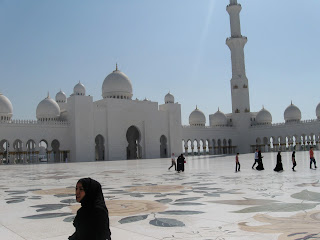Saturday, January 1, 2011
5 Things I Learned About Islam at the Grand Sheikh Zayed Mosque
My first trip to the Arabian Peninsula wouldn't be complete without visiting a mosque for the first time. The Sheikh Zayed Mosque in Abu Dhabi, constructed at a cost of several hundred million dollars, almost seems designed as an introduction to Islam for non-believers. At first glance it looks like the sultan's palace from the Aladdin cartoon I watched as a kid. Tour guides highlight the notable features, such as the world's largest carpet and chandelier, while mixing in some basic lessons about how Islam works. Our female tour guide was very knowledgeable and willing to answer our questions, and she even endured a goading Frenchman wanting to know the fate of her soul if she missed any of her daily prayers. Our guide confessed that she prefers sleeping in and so rarely makes morning prayer, but it didn't seem to trouble her much. One of the things that most impressed me about the mosque was its large central courtyard made of white tile so that it will stay cool under the unforgiving Arabian sun. This is especially important as guests must remove their shoes before entering the main structure.
To supplement everything I learned on my visit, I picked up Karen Armstrong's Islam: A Short History, which covers over four centuries of Islamic history in under 200 pages. Between the book and the tour, here are 5 things that I learned that changed my perspective a bit:
1) Like most religions, social justice is at the heart of Islam: The word "Islam" means, "to surrender," not in a military or political sense, but to the idea that Allah demands that people, "behave to one another with justice, equity and compassion" (Armstrong 5). Everything that Muslims do; daily prayers (salat), the Ramadan fast, the giving of alms (zakat - supposed to be 2.5% of one's income) - all of it supports the idea of a community (ummah) committed to this end. Islam arose as a rebellion against the corruption, wealth disparity, and constant tribal warfare that characterized pre- Muhammadian Arabia. So, while Christians are more comfortable with a separation between church and state (Christianity existed in rebellion against a more powerful state for its first 300 years), it is much harder for a Muslim to separate the ummah from politics.
2) Islam doesn't inherently denigrate or demote women: Karen Armstrong explains, "The emancipation of women was a project near and dear to the Prophet's heart. The Quran gave women rights of inheritance and divorce centuries before Western women were accorded such status" (16). The practice of veiling all women didn't emerge until a few hundred years after Muhammad's death. As some of the quirks of tribal Arabia were codified in the Quran fundamentalists seized on them and corrupted Muhammad's original vision. Take polygamy, for example; in the formative period of Islam the fighting left many men dead, and so the Quran allowed for men to take up to 4 wives, provided they treated each of them equally. Most of the controversy that gets played up in the Western media highlights fundamentalist perspectives and ignores the progressive equality present from the religion's founding.
3) The Sunni-Shia split is about a lot more than some guy named Ali: Nominally, the Sunni-Shi'a division which oft finds its way into the news is about succession. After Muhammad's death in 632, the ummah was divided over whether the Caliph should be elected, or whether he should be divinely ordained. Sunnis see Muhammad as solely divine, whereas Shi'a view Muhammad's cousin and son-in-law, Ali, as one of a handful of divinely inspired Imams. Armstrong explains that Shi'a Muslims interpreted Ali's murder, as well as subsequent tragedies, as "a symbol of the inherent injustice of life," and as a summoning to "higher Islamic standards" for a corrupt ummah. Whereas Sunnis became more tolerant of political divisions for the sake of continued unity, Shi'a focused on the need for purity. While each sect has its spectrum of believers ranging from fundamentalists to mystics, Shi'a generally afford more hierarchical power to Imams and have a less tolerant relationship with the state.
4) The Crusades weren't as big of a deal as we in the West think they were: A popular misconception these days is that the medieval Crusades to the Holy Land are the root cause for the animosity between the Muslim Middle East and the modern West. Armstrong debunks this myth, explaining, "Most of the inhabitants of Islamdon were entirely unaffected by the Crusades and remained uninterested in Western Europe, which, despite its dramatic cultural advance during the crusading period, still lagged behind the Muslim world" (179). Instead, lingering difficulties resulting from European colonialism and forced modernization are responsible for the discord between contemporary Middle Eastern Muslim societies and the globalizing world economy.
5) There is hope for moderate Islam to reconcile faith with modernity: Islam is not the source of conflict between Middle Eastern fundamentalists and the West; rather, it is a tool. Fundamentalist reactions almost always emerge in times of great change, and economic globalization is certainly forcing speedy change in every corner of the world. Grand Sheikh Zayed Mosque is an example of the opportunity for Islam to help bridge the cultural divide. As Abu Dhabi and Dubai modernize and receive vacationers and businesspeople from Europe, the mosque offers a different perspective from the one so prevalent in the news.
Subscribe to:
Comments (Atom)

